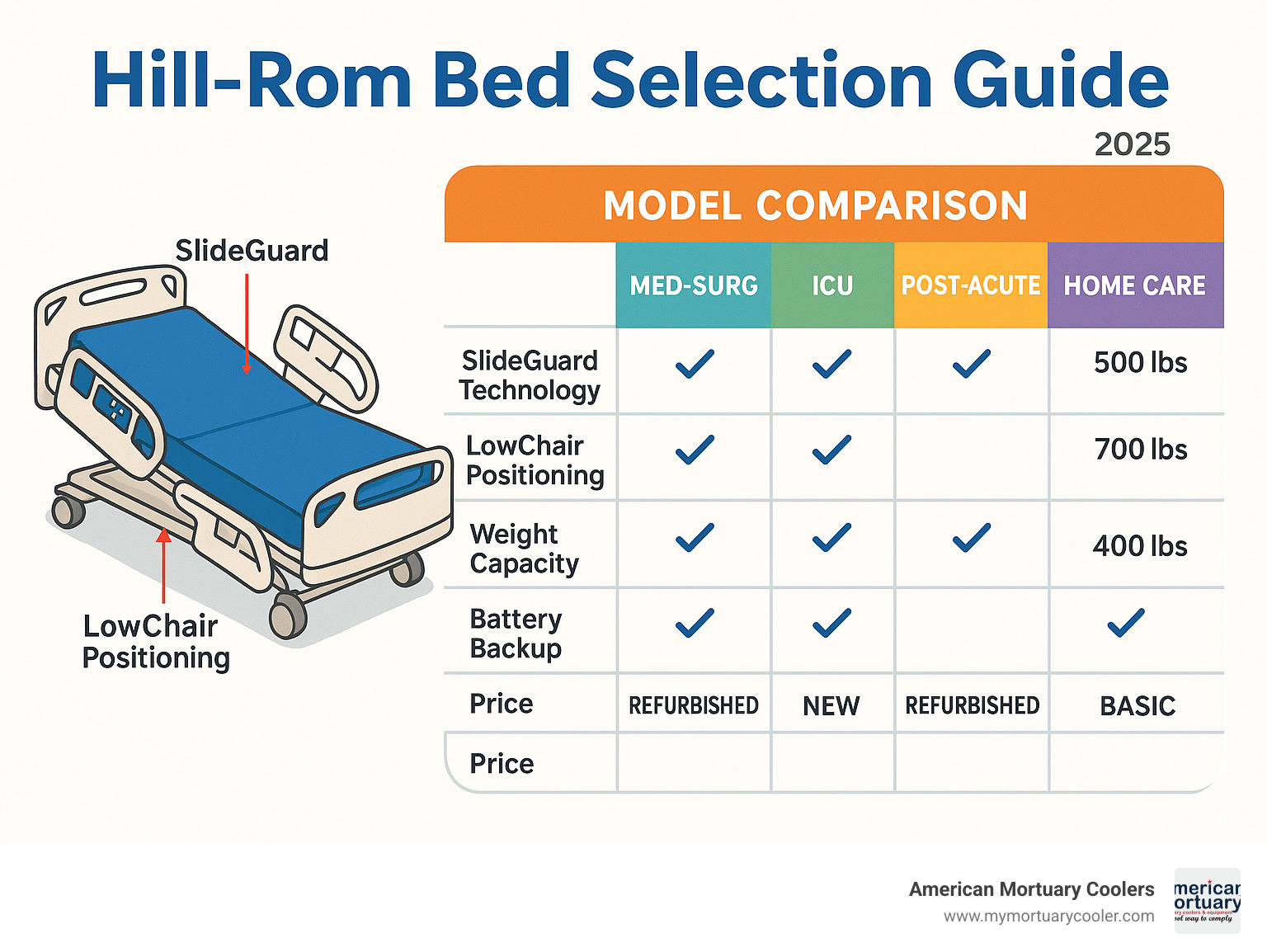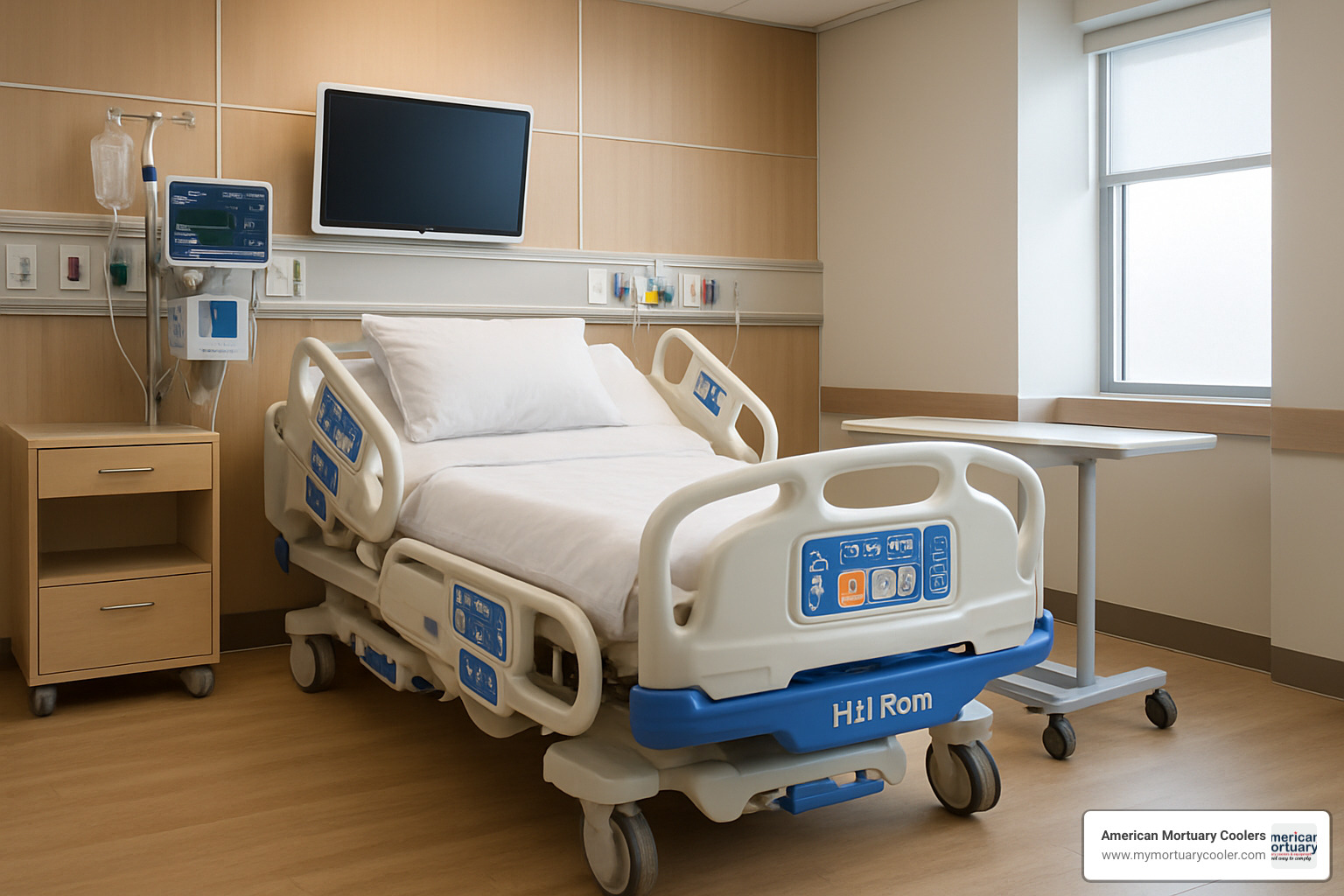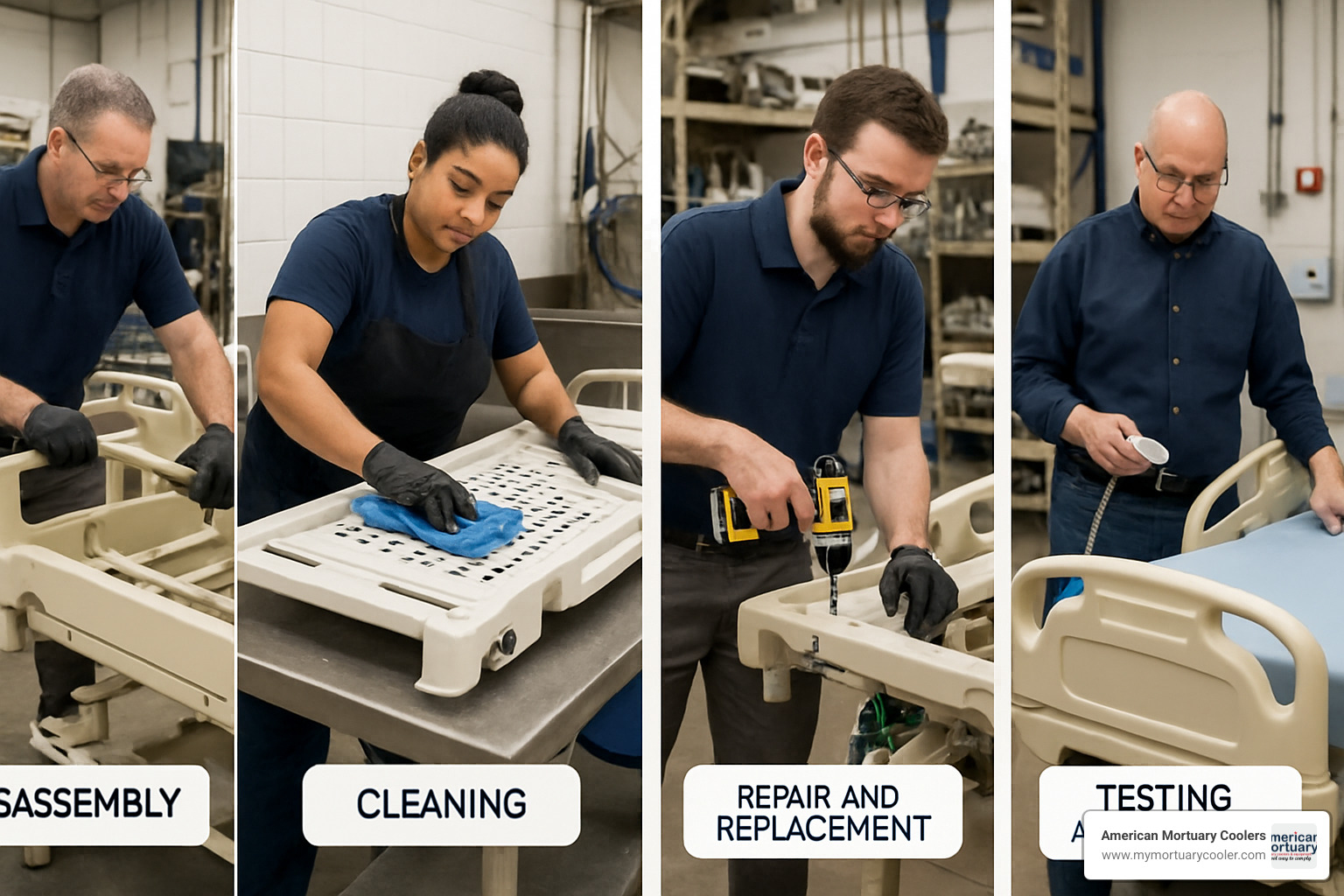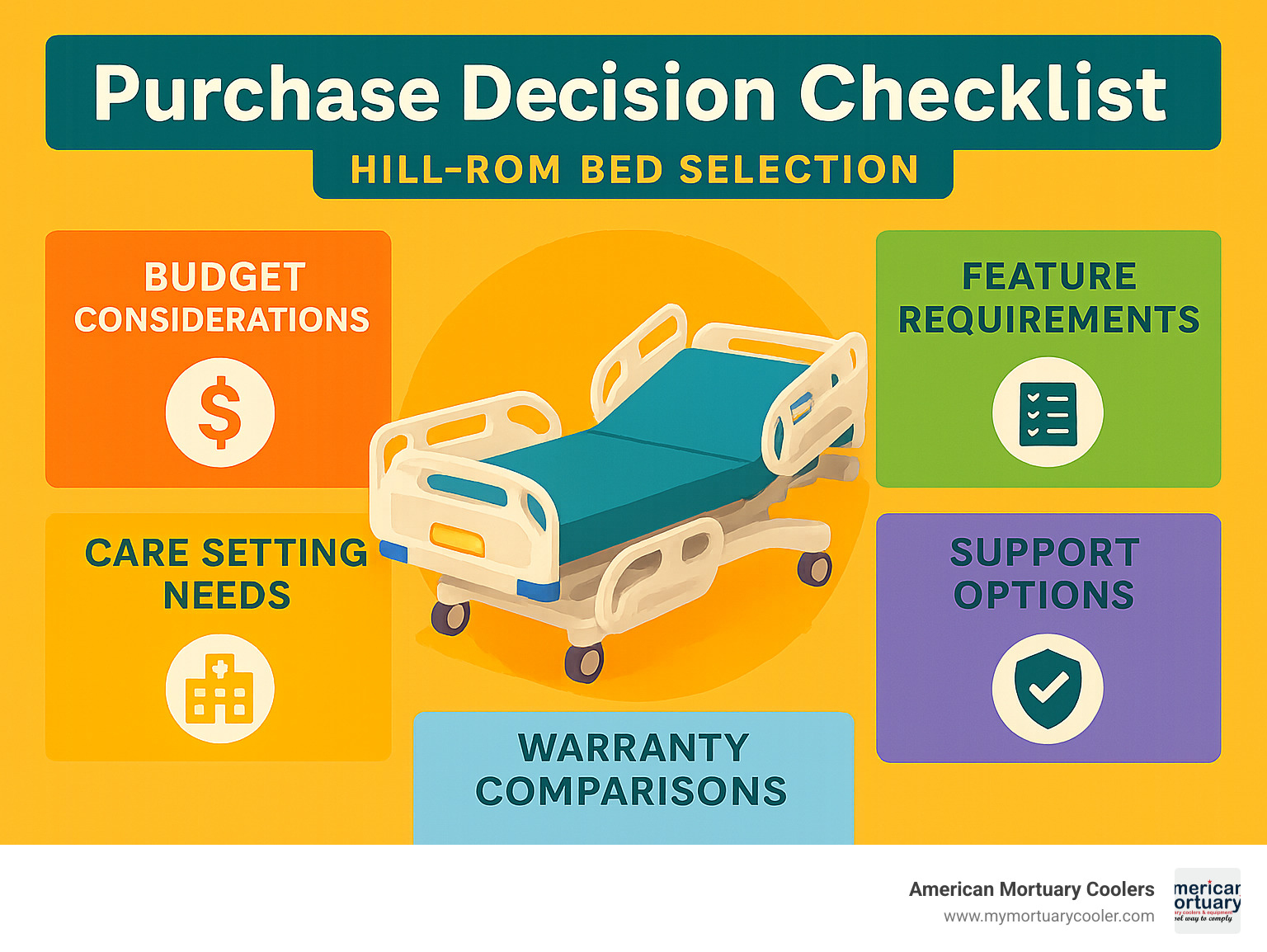
Ultimate Checklist for Buying a Hill Rom Bed
Why Hill-Rom Beds Are the Gold Standard in Healthcare
A hill rom bed is a technologically advanced hospital bed designed to improve patient safety, comfort, and clinical outcomes through features like SlideGuard technology, LowChair positioning, and integrated monitoring systems. These beds are widely used across healthcare settings from ICU to home care, with weight capacities up to 500 lbs and smart features that help reduce patient falls by up to 55%.
Key Hill-Rom Bed Features:
- SlideGuard Technology - Prevents patient sliding during bed elevation
- LowChair Positioning - Enables safe patient transfers and mobility
- FlexAfoot Extension - Adjusts bed length for different patient heights
- Battery Backup - Ensures functionality during power outages
- Smart Monitoring - Contact-free heart rate and respiratory monitoring
- Weight Capacity - Up to 500-700 lbs depending on model
Healthcare facilities face mounting pressure from chronic staffing shortages and increasingly complex patient needs. Hill-Rom beds address these challenges by combining safety, simplicity, and connectivity in one platform. The company has over 30 years of innovation in the US healthcare market, evolving from basic wooden hospital beds in the 1930s to today's smart monitoring systems.
Popular models include the Centrella Smart+ for med-surg units, Progressa+ for ICU care, and VersaCare for general medical use. Pricing ranges from $750 for refurbished models to over $15,000 for new smart beds with advanced surfaces.
As American Mortuary Coolers, we've worked extensively with healthcare equipment procurement and understand the importance of reliable, durable hill rom bed solutions that support both patient care and operational efficiency. Our experience helping facilities steer equipment decisions ensures you get the right bed for your specific needs.

What Sets a Hill-Rom Bed Apart?
When you're looking at hospital beds, you'll quickly notice that hill rom bed models have something special about them. After working with healthcare facilities for years, we've seen how these beds solve real problems that keep administrators up at night.
The secret sauce? Hill-Rom's commitment to Advancing Connected Care has created technologies that actually work in the real world. While other manufacturers focus on bells and whistles, Hill-Rom tackles the daily challenges that nurses and patients face every single day.
Take SlideGuard technology, for example. If you've ever watched a patient slowly slide down in bed as the head raises, you know how frustrating this can be. SlideGuard automatically adjusts the bed surface to keep patients in place, which means less repositioning for staff and better comfort for patients. It's one of those "why didn't someone think of this sooner" innovations.
LowChair positioning is another game-changer. The bed can lower to chair height, making transfers so much easier and safer. Combined with FlexAfoot extension that stretches the bed up to 12 inches longer, you can accommodate everyone from a petite elderly patient to a tall athlete.
The SafeView alarm system gives you visual cues about bed status from across the room. No more guessing if the brakes are set or wondering about the bed's position. The audible brake alarm on models like the CareAssist ES has prevented countless accidents.
IntelliDrive powered transport means one person can move these beds smoothly through hallways and around corners. With today's staffing challenges, anything that makes one person's job easier is worth its weight in gold. These beds support up to 500 pounds (700 for bariatric models), so they're built for real-world use.
The connected care features integrate with hospital systems to provide continuous monitoring and data collection. This isn't just fancy technology – it's information that helps make better care decisions.
Key Features to Look For in a hill rom bed
Battery backup keeps the bed working during power outages with up to 15 full positioning cycles. When the lights go out, your patients don't lose their ability to adjust their position for comfort or medical needs.
StayInPlace technology works with SlideGuard to maintain proper patient positioning no matter how the bed moves. Less repositioning means happier patients and less strain on your staff's backs.
Microclimate management controls heat and moisture around the patient's skin. This isn't just about comfort – it actively prevents pressure injuries, which affect 2.5 million Americans every year and cost hospitals thousands per incident.
The 3-mode bed exit alarm can be customized based on each patient's needs and cognitive status. A confused patient might need different monitoring than someone who's alert but at fall risk. The flexibility helps balance safety with dignity.
Progressive Mobility support follows the proven 5-step framework: Breathe, Tilt, Sit, Stand, Move. This systematic approach to getting patients moving again has shown remarkable results in reducing ICU stays and improving recovery times.
How a hill rom bed Boosts Patient Outcomes
The numbers don't lie, and Hill-Rom's results are impressive. Their Fall Reduction Guarantee has achieved a 55% reduction in patient falls across participating facilities. When you consider that a typical 200-bed hospital sees 358 falls per year, with each fall costing up to $10,000, this represents serious savings.
Pressure injury reduction of 33% comes from the combination of smart surfaces and microclimate management. The HAPI (Hospital-Acquired Pressure Injury) reduction guarantee backs this up with real data from real hospitals.
Early mobility support through FullChair positioning has produced some eye-opening results. One 33-bed medical unit reported 86% fewer code blue events, 45% fewer ICU transfer days, and 9% shorter overall stays. Those are the kinds of improvements that make a real difference in patient lives.
The continuous monitoring capabilities track heart rate and breathing without disturbing sleep or requiring additional equipment. This passive monitoring lets staff catch problems early, often before they become serious issues.
At American Mortuary Coolers, we understand the importance of reliable, durable equipment that performs when it matters most. The same attention to quality and dependability that goes into our mortuary equipment is what makes Hill-Rom beds stand out in healthcare settings.

hill rom bed Models & Care Settings
Hill-Rom offers specialized bed models designed for specific care environments and patient populations. Understanding these distinctions helps ensure you select the optimal solution for your needs.
VersaCare Med-Surg beds serve as the workhorse for general medical units. These beds combine essential safety features with reliability, offering weight-based pressure redistribution, Auto Contour positioning, and Boost repositioning assistance. The VersaCare line supports patients up to 500 lbs and includes Advanced Microclimate Management.
CareAssist ES beds feature the audible 'brake not set' alarm and comprehensive positioning options including Trendelenburg and Reverse Trendelenburg. These beds excel in environments where patient mobility varies widely and safety protocols are paramount.
Advanta 2 beds incorporate LowChair positioning and FlexAfoot retraction/extension with reliable battery backup. This model bridges basic functionality with advanced positioning capabilities.
Progressa+ ICU beds represent the pinnacle of critical care technology. These "True ICU beds" integrate skin protection, pulmonary therapy, and early mobility support in one platform. Features include Continuous Lateral Rotation Therapy, percussion and vibration therapies, and FullChair sit-to-stand positioning.
TotalCare SpO2RT 2 beds are rental-only ICU solutions that combine multiple pulmonary and mobility therapies with comprehensive data tracking. These beds support early mobility strategies while providing therapy reminders and safety stops.
Centrella Smart+ beds bridge med-surg and ICU environments with contact-free continuous monitoring, SafeView+ visual icons, and improved bed exit alarms. The ReadyConnect wireless system eliminates cable management challenges.
Affinity birthing beds feature specialized obstetric positioning with EasyGlide calf support and no-lift stow-and-go foot sections. These beds support the unique needs of labor and delivery environments.
Bariatric models like the 1840 series accommodate patients up to 700 lbs with reinforced frames and improved stability features.
Care setting applications vary significantly. Med-Surg units typically use VersaCare or CareAssist models for their balance of features and reliability. ICU environments benefit from Progressa+ or TotalCare models with advanced monitoring and therapy capabilities. Long-term care facilities often prefer simpler models with essential safety features and durability. Home care applications typically focus on reliability, ease of use, and caregiver support features.
Many advanced models are available as rental-only options, providing access to cutting-edge technology without the capital investment required for purchase.
Comparing Flagship Series
Centrella Smart+ beds excel in med-surg environments with their contact-free monitoring capabilities and 55% fall reduction guarantee. These beds support patients up to 500 lbs with surface options ranging from basic foam to advanced air surfaces. Key mobility features include FlexAfoot extension and IntelliDrive transport.
Progressa+ ICU beds target critical care with integrated pulmonary therapies and early mobility protocols. Weight capacity reaches 500 lbs with three surface tiers: Essential (non-powered), Advance (integrated powered air), and Accelerate (advanced powered air with therapy modes). The FullChair positioning supports sit-to-stand protocols.
Envella AIR beds focus on pressure injury prevention with advanced air surface technology and continuous monitoring. These beds integrate seamlessly with hospital IT systems while providing comprehensive patient positioning options.
| Feature | Centrella Smart+ | Progressa+ ICU | Envella AIR |
|---|---|---|---|
| Weight Capacity | 500 lbs | 500 lbs | 500 lbs |
| Surface Options | Core/Pro/Pro+/Max | Essential/Advance/Accelerate | Advanced Air |
| Mobility Features | FlexAfoot, IntelliDrive | FullChair, Progressive Mobility | Standard Positioning |
| Monitoring | Contact-free HR/RR | Integrated Alarms | Continuous Monitoring |
| Primary Setting | Med-Surg | ICU | Med-Surg/Step-down |
New vs Refurbished vs Reconditioned
When shopping for a hill rom bed, understanding the different condition tiers can save you thousands while still getting the quality you need. Think of it like buying a car - you have new, certified pre-owned, and used options, each with their own benefits.
New beds are exactly what you'd expect - fresh from the factory with all the latest bells and whistles. You'll get the newest software updates, pristine appearance, and full manufacturer warranties. The downside? Your wallet will definitely feel it. A new Centrella Smart+ bed can easily run over $15,000 depending on what features you choose.
Refurbished beds get the "quick refresh" treatment. These units go through cosmetic renewal with basic cleaning, minor repairs, and touch-ups to make them look presentable again. It's like giving an old car a wash and wax - it looks better, but the engine hasn't been rebuilt. A refurbished P3200 VersaCare bed starts around $1,995 with a foam mattress, jumping to $2,495 with an air mattress. That's serious money saved compared to buying new.
Reconditioned beds receive the full spa treatment. We're talking complete disassembly, thorough cleaning, component repair or replacement, fresh paint, reassembly, new labels, and comprehensive testing. It's the difference between a car wash and a complete engine rebuild. The price difference shows this too - a Centra bed costs $750 refurbished but $1,675 reconditioned, while an Advance 1000 jumps from $1,000 refurbished to $2,195 reconditioned.

The reconditioned beds go through a rigorous 6-point inspection that covers everything from electrical system testing of all motors and controls to mechanical component inspection of the frame and moving parts. Safety feature verification ensures all alarms and emergency functions work properly, while surface condition assessment checks the mattress platform and rails. Compliance testing confirms everything meets regulatory standards, followed by final quality assurance with complete operational testing.
Warranty coverage varies dramatically between these options. New beds typically come with 2-3 year comprehensive warranties that cover just about everything. Refurbished units might give you 90 days to a year of limited coverage - enough to catch any major issues but not much more. Reconditioned beds often split the difference with 1-2 year warranties, depending on how extensive the reconditioning process was.
Delivery timelines also tell a story. New beds can take 4-8 weeks since they're made to order. Refurbished units are usually ready to ship within 2-4 weeks since they're already in inventory. Reconditioned beds need 3-6 weeks depending on how much work they require.
Even high-end models become more accessible through reconditioning. A TotalCare P1900 with advanced air mattress systems runs $7,495 reconditioned - still a significant investment, but much more reasonable than new pricing for access to sophisticated therapy capabilities.
At American Mortuary Coolers, we understand the importance of getting reliable equipment that fits your budget. Whether you're outfitting a new facility or replacing aging equipment, choosing the right condition tier for your hill rom bed can make a huge difference in both upfront costs and long-term satisfaction.
Buyer's Checklist: Budget, Mattress & Support
When you're shopping for a hill rom bed, the first reality check is budget. Prices swing dramatically - from $750 for basic refurbished models all the way up to over $15,500 for new smart beds loaded with advanced surfaces. That's quite a range, but it makes sense when you consider the massive difference between a simple med-surg bed and a fully-equipped ICU unit with all the bells and whistles.
The mattress choice might seem like an afterthought, but it's actually one of your most important decisions. Foam mattresses keep costs down and work fine for lower-risk patients who don't spend extended time in bed. Air mattresses step up the game with dynamic pressure adjustment - essential if you're dealing with patients at higher risk for pressure injuries. Low air loss surfaces are the premium option, providing continuous airflow to manage moisture. If you're caring for someone with existing pressure injuries or serious mobility limitations, this feature can make a real difference in healing outcomes.
Here's something that sounds minor but isn't: Boost repositioning features. These help move patients toward the head of the bed without caregivers having to do all the heavy lifting. Trust me, after a few months of manually repositioning patients, your back will thank you for investing in this feature.
Parts availability becomes crucial down the road. Popular models like the P3200 VersaCare have excellent parts support, but if you're looking at a discontinued model that's been out of production for years, you might find yourself hunting for parts when something breaks. We always recommend checking parts availability for any bed over 10 years old before making a purchase.
Service contracts range from about $150 for one year to $250 for three years, covering diagnostics, labor, and repairs. For home care situations where you don't have a maintenance team on staff, these contracts provide real peace of mind and predictable costs.
Don't forget about shipping logistics. Standard delivery is usually free, but if you need delivery and setup services, expect to pay around $850 or more. For complex installations or if your team isn't comfortable with technical setup, professional installation is worth every penny.
Our experience at American Mortuary Coolers has taught us that equipment decisions often tie into broader operational challenges. If you're dealing with related equipment needs, our Complete Guide to Finding Replacement Chair Lift Parts might be helpful. The current latest research on nursing shortage also provides valuable context for understanding why equipment that reduces caregiver strain has become so important.
Must-Ask Questions Before Purchase
Room clearance goes way beyond just measuring the bed itself. You need space for full articulation, side rail operation, and caregiver access from all angles. ICU beds are particularly space-hungry compared to basic med-surg models. Measure twice, order once - nothing's worse than a bed that doesn't fit properly in the room.
Power requirements typically mean two outlets, and placement matters more than you might think. Some newer models include USB charging ports for patient devices, which is a nice touch that patients really appreciate.
Training needs vary dramatically between models. Basic beds are pretty intuitive, but if you're getting advanced features like therapy modes and monitoring systems, plan time for proper training. Untrained staff can miss important features or, worse, create safety issues.
Weight considerations aren't just about maximum capacity. A 400-pound patient might need a 500-pound capacity bed to handle the dynamic forces during repositioning. Think about real-world use, not just static weight.
Warranty details deserve careful attention. What's actually covered? How fast do they respond to service calls? Do you get a loaner bed during repairs? For critical care applications, 24/7 support availability isn't a luxury - it's essential.
Frequently Asked Questions about Hill-Rom Beds
How do I choose the right model for home use?
Choosing the right hill rom bed for home care feels overwhelming at first, but focusing on three key areas makes the decision much clearer: reliability, simplicity, and caregiver support.
The CareAssist ES and VersaCare models consistently perform well in home environments because they balance essential positioning features with straightforward operation. These beds don't overwhelm family caregivers with complex controls, yet they provide the safety features that matter most.
Think carefully about who will be operating the bed daily. If it's a spouse or adult child without medical training, features like Boost repositioning become incredibly valuable - they reduce the physical strain of caring for a loved one. The battery backup system also becomes more critical at home, where you can't rely on immediate professional assistance during power outages.
Weight capacity deserves extra consideration in home settings. Choose a bed that accommodates not just your loved one's current weight, but potential changes over time. A patient who weighs 350 pounds today might benefit from a 500-pound capacity bed to ensure safe operation as their condition evolves.
Mattress selection often makes the biggest difference in home comfort. Patients spending most of their day in bed need more than basic foam surfaces. Low air loss surfaces might seem expensive initially, but they're often worth the investment for preventing pressure injuries that could lead to costly hospitalizations.
What maintenance does a Hill-Rom bed require?
Hill rom bed maintenance isn't complicated, but consistency matters more than you might expect. Daily care involves simple cleaning with approved disinfectants and a quick visual check that everything looks normal.
Weekly maintenance takes just a few minutes but catches problems early. Test the bed exit alarms, check that brakes engage properly, and ensure all positioning functions work smoothly. These weekly checks often prevent bigger issues down the road.
Monthly battery testing ensures your backup power works when you need it most. Simply unplug the bed and cycle through a few positioning changes - the battery should handle this easily. If it struggles, you'll know to call for service before an emergency happens.
More comprehensive maintenance happens quarterly and includes lubricating mechanical components, inspecting electrical connections, and calibrating monitoring systems. Many families find it helpful to schedule this maintenance around seasonal changes - it's easier to remember.
Annual professional service is worth every penny, especially for beds in constant use. Professional technicians spot wear patterns and potential issues that aren't obvious to daily users. They also update software and ensure all safety systems meet current standards.
Keep a simple maintenance log - even just dates and basic notes. This documentation helps with warranty claims and gives service technicians valuable information about your bed's history.
Where can I buy parts or get technical support?
Hill-Rom's parts network makes finding components surprisingly straightforward. Their online parts portal lets you search by your specific bed model number, which eliminates guesswork about compatibility. Just locate your model number on the bed frame and enter it into their system.
Technical support comes through multiple channels, and Hill-Rom generally provides helpful service. Phone support handles most questions quickly, while their online resources include troubleshooting guides and video tutorials for common issues. For complex problems, field service technicians can visit your location.
Response times depend heavily on your service contract level. Basic support might take a few days, while premium contracts offer 24/7 support and expedited parts delivery. For home care situations, consider whether faster response times justify the additional cost.
Third-party suppliers often offer Hill-Rom compatible parts at lower prices. We've seen families save significantly on items like mattress covers, side rail pads, and basic mechanical components. However, verify compatibility carefully and understand that non-OEM parts might affect warranty coverage.
For complex repairs or safety-critical components, stick with authorized Hill-Rom parts and service. The peace of mind is worth the extra cost, especially when a loved one depends on the bed for daily care.
At American Mortuary Coolers, we understand the importance of reliable equipment and responsive support. While our expertise centers on mortuary cooling solutions, we've seen how equipment reliability affects families during difficult times. The same principles apply to hill rom bed selection - choose quality, plan for maintenance, and ensure you have support when you need it most.
Conclusion
Choosing the perfect hill rom bed comes down to understanding your specific needs and finding the sweet spot between features, budget, and long-term value. After working through the decision factors we've covered, you'll be well-equipped to make a choice that truly serves your patients and caregivers.
The beauty of Hill-Rom's extensive lineup is that there's genuinely something for every situation. Whether you're outfitting a busy ICU with Progressa+ beds that deliver critical monitoring, or setting up home care with reliable VersaCare models, the key is matching the bed's capabilities to your actual daily challenges.
Budget considerations don't have to mean compromising on quality. A refurbished P3200 at $1,995 can deliver excellent patient outcomes when properly maintained, while a new Centrella Smart+ system might be the perfect investment for facilities focused on fall reduction and staff efficiency. The 30+ year track record behind these beds means you're investing in proven technology, regardless of which condition tier fits your budget.
Here at American Mortuary Coolers, we understand the critical importance of reliable healthcare equipment. While we specialize in crafting custom mortuary coolers and related equipment for funeral homes across Tennessee, Georgia, Illinois, South Carolina, Texas, California, New York, and Pennsylvania, our experience with durable healthcare solutions gives us deep appreciation for equipment that truly supports caregivers in their daily work.
Just as we deliver custom solutions nationwide across the contiguous 48 states, your hill rom bed selection should reflect the same commitment to quality and long-term reliability. The right bed becomes an invisible partner in patient care - supporting healing, reducing caregiver strain, and quietly contributing to better outcomes every single day.

This investment pays dividends far beyond the initial purchase price. Improved patient outcomes, reduced workplace injuries among staff, and the peace of mind that comes with reliable equipment all contribute to your facility's success. Take your time with the evaluation process, ask the tough questions about parts availability and service support, and choose the solution that best aligns with your care mission.
For additional insights into healthcare equipment solutions and our approach to durable, custom equipment, visit us for more info about cooling solutions. Whether you're selecting hospital beds or any other critical healthcare equipment, the principles of quality, reliability, and thoughtful customization remain the same.



